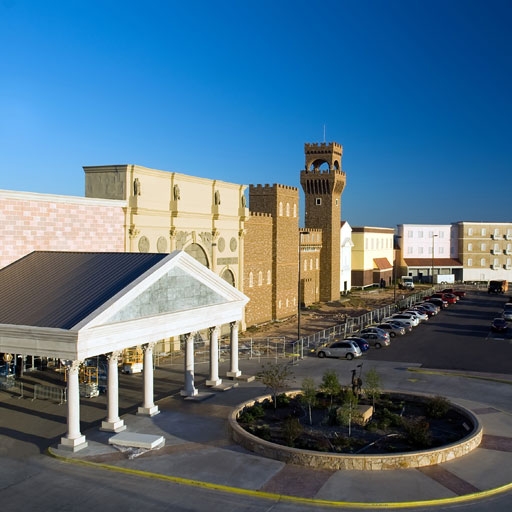
Winstar World Casino
The revitalization of the Winstar World Casino in Thackerville, Oklahoma is a signature project for Stromberg Architectural Products of Greenville, Texas. For this endeavor, Stromberg utilized its full production capacity, creative design and material options to create a masterpiece for the visual appreciation of visitors to the gaming facility located on Interstate 35 in southern Oklahoma. Collaborating hand in hand with the Architectural Administration Department of the Chickasaw Nation, the end result is both a showcase of Stromberg's production capabilities and an homage to the masters of architecture that have come before.
The Winstar Exterior
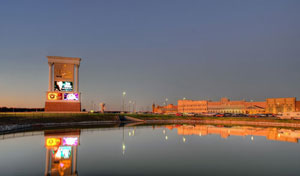
The exterior of the Winstar World Casino is a walking tour of architectural history and style. Designed by the creative team at Stromberg, the building's exterior façade begins in London, England and finishes in the far reaches of Asia. There are 11 different sections along the casino's perimeter; each representing a unique contribution to the architectural world. Beginning on the north side of Winstar and moving south, the sections contained include the following:
Big Ben
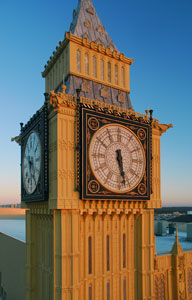
Big Ben is the nickname for the Palace of Westminster's bell tower. One of London's most famous tourist attractions, it has the largest four-faced chiming clock and is the third tallest free-standing clock tower in the world. With the Westminster Palace, it is now a UNESCO World Heritage Site. The original 1800s drawings and gothic details by architects Pugin and Barry were used by Stromberg for the Winstar reproduction. The Winstar Big Ben is the largest tower clock in Oklahoma and was erected in 2009 to commemorate the 150th birthday of London's original.
Palace of Westminster

The original Palace of Westminster lies on the north bank of the Thames River in London. The palace began in the Middle Ages but was rebuilt and remodeled frequently due to many devastating fires. The current version, built in the 1800s, took over 30 years to complete. The elegant turrets were actually chimneys, and the statues represent heroes from British history. The Winstar version of the Palace of Westminster was built in 2009. The panels, statues and gothic details were sculpted and cast by Stromberg based on design drawings from the original.
The Rise of Castles in Europe
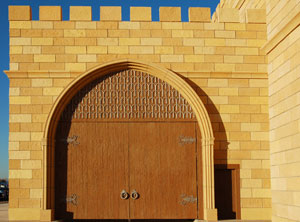
Castles, perhaps the most romanticized structures ever built, arrived in Europe in the 10th century and were the next step in development from the hill forts of the bronze and iron ages. Castles exploded across the English countryside following the victory of William the Conqueror in the Battle of Hastings in 1066, and at one time there were more than 10,000 of them dotting the landscape across Spain. Stromberg designed the Castle wall at Winstar with inspiration from the concentric castle design which began to emerge in the late 13th century.
Puerta de Alcal�
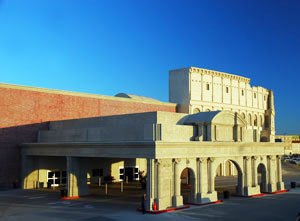
Puerta de Alcal� is the centerpiece in Madrid's Plaza de Indepencia. It was originally built to mark the beginning of a path from the capital city to the historic nearby city of Alcal� de Henares. The monument was commissioned by King Carlos III and designed by Italian architect Francesco Sabatini. The gateway is built in the style of a Roman triumphal arch. The original monument was completed in 1778, then moved to its current location in the city's center in the 19th century. Stromberg installed Winstar's version of the Puerta de Alcal� in 2009.
The Roman Colosseum

The Colosseum in Rome is one of the greatest architectural marvels of history. It was commissioned by Emperor Vespasian in 72 A.D. and completed by his son Titus in 80 A.D. The work required to build such a structure necessitated the use of upwards of 30,000 laborers. The original venue was most famously the home of gladiator contests, but was also the home to mock naval battles, hunts, reenactments of historical conflicts and dramatic performances. As an entertainment venue, it stayed in use for nearly 500 years.
Doge's Palace
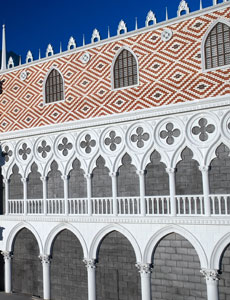
Doge's Palace is one of the most recognizable landmarks in Venice, Italy. Built for the republic's elected ruler, the palace was renovated and reconstructed many times from the 9th century until the current building was finished in 1420. The present incarnation was largely the work of architect and sculptor Filippo Calendario. In addition to being the Doge's residence, it was also the location of courts of law, the Sala del Maggior Consiglio (Hall of the Great Council), offices of bureaucracy and at one time even the city's jail.
The Pantheon

Almost 2,000 years after its construction (126 A.D.) the Pantheon in Rome remains the world's largest unreinforced dome, therefore one of the great marvels of architectural accomplishment. Within the Pantheon are the tombs of artists, composers, architects and even two kings. It was given to Pope Boniface IV in 609 A.D. at which time it became a church, and mass is still celebrated there to this day. Stromberg of Greenville, TX recreated the portico of the Pantheon in recognition of its unending impact on the world of architecture, serving as the inspiration for scores of monumental buildings, including the U.S. Capitol in Washington, D.C.
The Triumphal Arch
The Triumphal Arch is a globally recognized architectural statement that traces its origins back to Rome, though no one knows exactly when the first one was built. These arches were often built to commemorate a great victory in battle or in honor of a specific ruler. The first reference to them in literature dates all the way back to the first century. In the centuries since, triumphal arches have been built worldwide. Today, massive Triumphal Arches are available to be visited in more than 35 different countries. Now there is one more, created by Stromberg of Greenville, which stands at Winstar Casino in Oklahoma.
Palazzo Vecchio
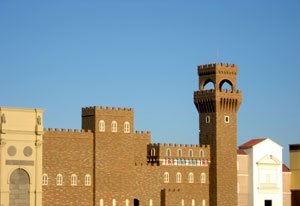
Florence's town hall, a Romanesque fortress-palace, overlooks the Piazza della Signoria and is one of the most celebrated public places in Italy. It was originally called the Palazzo della Signoria, after the Republic of Florence's ruling priori. It was built at the turn of the 13th and 14th centuries, though further additions to the building in the 15th and 16th centuries significantly increased its architectural scale. Within the Palazzo is the Salone dei Cinquecento, a massive assembly hall for the General Council of the People. Stromberg of Greenville, TX recreated this Italian masterpiece for Winstar World Casino.
The streetscapes of Europe

Quaint and charming, the simplicity of Europe's city streets makes them architectural artworks in and of themselves. Many a traveler has indulged in the fluctuating frontages that create a distinguishing look to the common, more residential quarters of Europe's cities both large and small. The patchwork of different constructions, built or replaced at different times over centuries, blend together to create a singular composition of timeless, yet humble elegance. Stromberg Architectural Products drew the inspiration for this section of the Winstar World Casino from the smaller residential avenues found across the European continent.
Foundations of the Far East
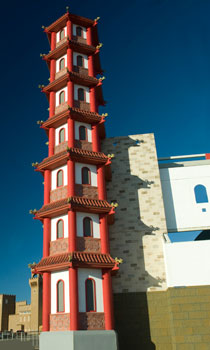
The Asian façade at Winstar draws its inspiration from traditional Chinese and Japanese hallmarks of architectural accomplishment, reproduced by Stromberg. The Great Wall of China, completed during the Ming dynasty, is visible as the centerpiece of this section of Winstar. Also present are a gate and fortified walls from the design of medieval Samurai Castles. The cornerstone of the Asian façade at Winstar is the Pagoda, which originally came from India and meshed with Chinese design to create one of the most recognizable icons of architecture worldwide.
The Interior of Winstar
While the exterior façade of Winstar World Casino is, without a doubt, a monumental accomplishment; Stromberg's work was not done. From there, Stromberg's team moved to the interior of the project to help establish the casino as a truly world class facility, both inside and out.
New York
You enter the Winstar World Casino through New York's Grand Central Terminal, faithfully recreated by the Stromberg design team. Immediately you will set your eyes on Lady Liberty as she watches over the entertainment floor. The Brooklyn Bridge compliments the skyline of the Big Apple. The elements that make up the streetscapes are presented to the Winstar visitor, complete with fire, police and post office facilities inspired by the actual buildings in the big city. There's even a chance to wander by Central Park. And what trip to New York would be complete without an excursion to the city's famous subway system? It's all there, courtesy of Stromberg Architectural Products.
Egypt
From New York, you can wander through the streets of a bustling bazaar directly into the heart of Egypt. Two powerful Sphinxes stand guard in the area, and from the moment you pass through the ancient Egyptian gate, hieroglyphics speak tales of the distant past in a land far away. Horus, Anubis, Isis, Osiris; all of the familiar characters of Egyptian lore are present. In the canopy over the Black Jack tables, the walls and the columns throughout; you will find the intricate recreations of artwork that is the hallmark of Egypt's past culture and Stromberg's current commitment to excellence in design and production. In need of some cash at this point? Look for the Obelisks which house the ATM stations conveniently located in this section.
Vienna
Otto Wagner achieved worldwide recognition when he built Karlsplatz Plaza in what was one of the most modern cities of the time. At Winstar World Casino, we celebrated that spirit with the creation the Vienna section of the casino's interior. Wagner's Jugendstil architecture is apparent in the high limits pavilion and adjacent Black Jack gaming area. In the 1980s the original Karlsplatz Plaza was scheduled for demolition before a public outcry saved the buildings for posterity's sake. Stromberg took this architectural acknowledgement one step further by recreating Karlsplatz within the walls of the Winstar World Casino in Thackerville, Oklahoma.




